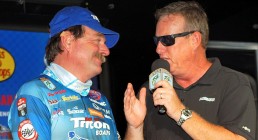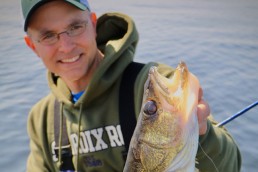Post-spawn Bassin’ in Weedy Lakes
SHARE THIS POST
A major shock to my fishing culture was leaving the friendly confines of deep, rocky, man-made reservoirs during the bass spawn to hang out in a geographical area with shallow weedy lakes. It may not seem like much, but the difference to a bass and an angler is striking. In reservoirs, especially hilly land or highland, bass find clay or pea gravel bottoms on flats adjacent to deep water. They seek out edges and objects like dock ramps, walkways and even overhead dock cables as cover for spawning.
In shallow, weedy, natural lakes like those in the Deep South or Upper Midwest, they still use walkways, but other spawning opportunities include weed pockets, weedlines and lily pad roots. Also, bottom strata are different. In natural lakes, they sweep out beds in sand, silt or algae-covered areas.
Fishing for pre-spawn, spawn and post-spawn bass can be quite a challenge, but here, Shaw Grigsby, Bassmaster Elite Series competitor and host of One More Cast, has tips to use. Grigsby has 59 top-ten finishes while winning over $2,116,800, including first place at the 2011 Bassmaster Elite Series, “Sunshine Showdown” on Florida’s Harris Chain of Lakes in Tavares.
Grigsby often uses larger soft plastics during the spawn.
“I like soft plastics in the 4- to 5-inch range,” Grigsby says.
He believes there are good numbers of bass from 4 to 7 pounds, from Florida on up to the lakes of Missouri and even farther north where fish readily strike larger lures.
“For color, I prefer white. Not for the fish, because it doesn’t care that much the color, but so I can see the where the bait is in relation to the bed and the bass.”
He also believes anglers work their baits too fast and too far without realizing it.
“Drop a quarter or a half dollar in a pool sometime, cast beyond it and work the lure back. You will see each time you pull it forward that it probably moves 6 inches or more.”
Experience has shown Grigsby that very small, forward movements with frequent pauses will trigger more strikes.
Are you enjoying this post?
You can be among the first to get the latest info on where to go, what to use and how to use it!
“You want the lure to get there (in the bed) and not slide across the bottom real fast. You have to learn how to move it very slowly.”
Once the eggs have hatched, a male stays with them as a protector while the female may stay and help for a while. But eventually she leaves to feed, rest and recuperate.
During the post-spawn, Grigsby likes topwaters and fast-moving jerkbaits or lipless crankbaits like Strike King’s 3/4-ounce Red Eye Shad.
“For the big females, you want it to pop off the bottom or rip through the weeds. For the males, I like topwaters and jerkbaits.”
He throws the lipless crankbaits on 17-pound-test fluorocarbon line because it sinks.
“You have to work at it; some patience is required to rip the lure through the edge of a weedline. Depending on the weeds, you may want to use 50-pound braided line instead of fluorocarbon since it doesn’t stretch.”
He does not use a fluorocarbon leader, and instead he opts for Seaguar’s braid, which is black. If his braided line is not already black he uses a black waterproof magic marker to color the last 10 feet of line above a lure.
While filming a spinnerbait segment for his television show at Lake Amistad in Texas he found the braided line outfished fluorocarbon because it cut through the Hydrilla better, and, because of its smaller diameter, it allowed the spinnerbaits to run deeper.
Try these proven techniques from Grigsby, a veteran bass fisherman and proven tournament winner. They will improve your post-spawn basin’.
MWO
SHARE THIS POST
You may also like...
0 CommentsInsider Secrets to Summer Bassin’ in Ozarks Lakes
Did you enjoy this post?
You can be among the first to get the latest info on where to go, what to use and how to use it!
Darrell Taylor
Darrell Taylor has fished for more than 65 years. During the past 25 years, Taylor has generated more than 2,000 published articles, columns and fishing reports. His writings received 14 peer-level awards from outdoor writer organizations, including the Association of Great Lakes Outdoor Writers “Excellence in Craft” Golden Glow Award, their highest recognition.


